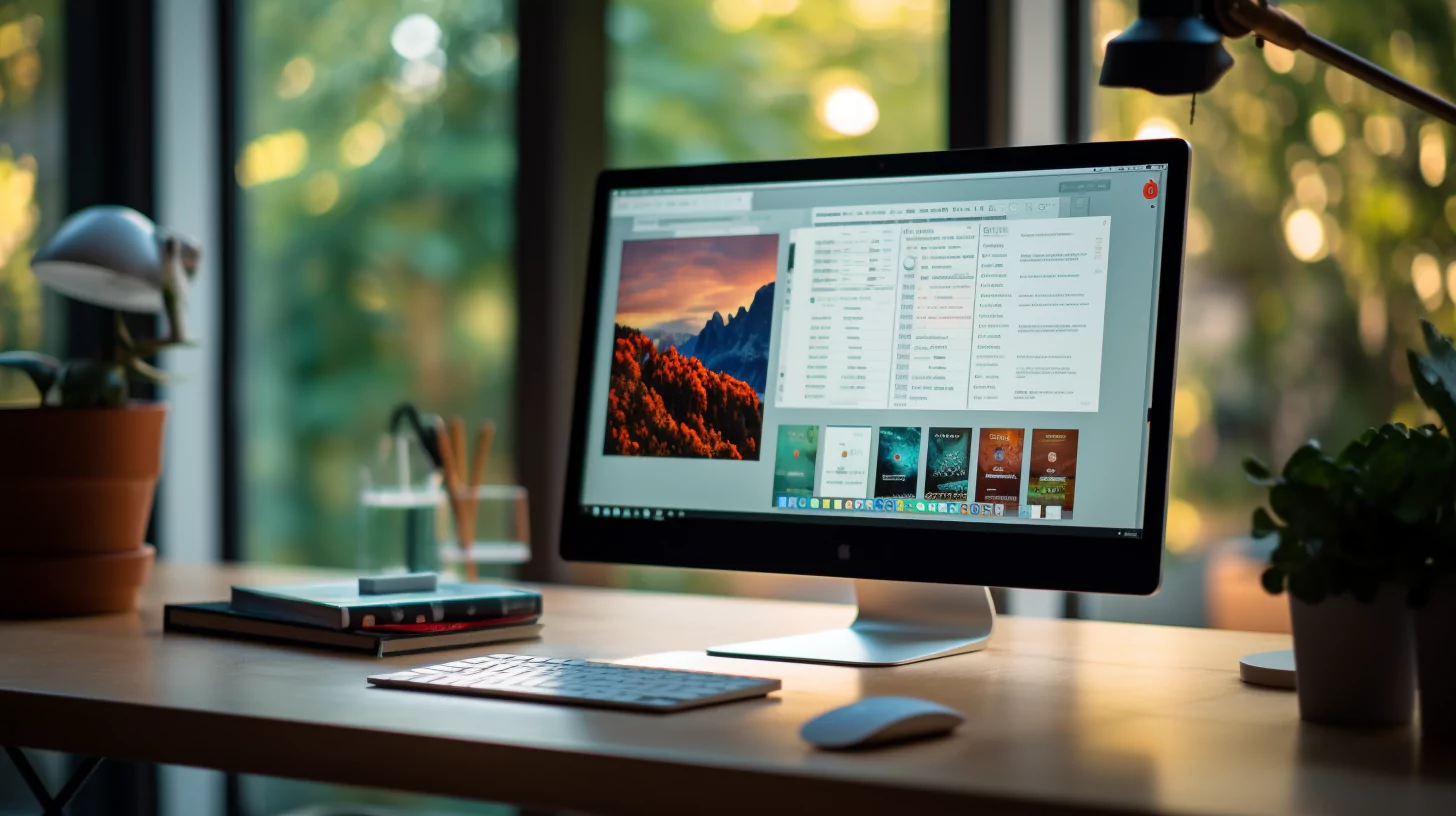It’s likely you’ve experienced this—you have a to-do list planned for your day. You start one task… Then, one or two more… And the next thing you know, it’s quitting time, and you’ve only gotten halfway through.
Let’s face it: humans are busy people. And in the span of 24 hours, we have plenty to do. Between work and family life, we’re lucky if we can snag a simple 15 minutes of downtime at the end of the day to decompress.
So, what can help with the chaos? Productivity tools.
The thing is, too much of our time is wasted on ineffective efforts. We are able to focus more, do more in less time if we’re better organized. It’s all about adhering to the task at hand, staying focused, and knowing in what direction we’re headed.
What are productivity tools?
Productivity tools are exactly what they sound like: tools that help you be productive, a.k.a., organize and structure your time, stay on top of what needs to be done, and be as effective as you can be. You can find this in the form of software apps, services, or even physical methods, all of which help with:
- Streamlining workflows
- Automating repetitive tasks
- Organizing information
- Improving collaboration
- Managing time
These tools offer quite a number of benefits, according to research. For instance, almost all workers (over 90%) in a 2023 survey by the Harvard Business Review said that using automation tools helped them get more work done. Plus, most of them (85%) also said these tools made it easier for their teams to work together.
The unfortunate thing is, we all complain about being too distracted, as Nir Eyal, a habit-forming expert and trainer of Mindvalley’s Becoming Focused and Indistractable Quest, points out. “But 99% of people can’t tell you what they’re being distracted from.”
But by changing the way you approach the things you’d like to get done, you’ll find it much easier to be more productive.
10 G.O.A.T. productivity tools
Undoubtedly, there are plenty of productivity tools out there to choose from. The question is, where do you start?
Here’s a list of the ones that have, so far, lasted the test of time:
1. Pomodoro Technique
This approach helps you tackle tasks in manageable chunks, breaking down work into 25-minute intervals of focused work with short breaks in between. Each interval is called a “pomodoro,” named after the tomato-shaped kitchen timer the creator of the technique used.
This method can help maintain concentration and prevent mental fatigue. Moreover, it can improve time management as well as boost motivation so that you don’t feel so burned out.
Here’s how you do it:
- Choose a task.
- Set a timer for 25 minutes.
- Work on the task without distractions until the timer rings.
- Take a short, five-minute break.
- Repeat steps 1-4 for four cycles.
- Take a longer, 15-20-minute break.
2. The Eisenhower Matrix
This is a simple decision-making tool that categorizes tasks based on what’s urgent and important. By doing so, you can reduce your decision fatigue, ensure you dedicate time to high-impact tasks, and prevent getting overwhelmed by trivial things.
Here’s how to use it:
- Draw a matrix with two axes.
- Put “Urgent” and “Not Urgent” on the x-axis, and “Important” and “Not Important” on the y-axis.
- Place your tasks in the quadrants:
- Urgent & Important: Do immediately.
- Not Urgent & Important: Schedule for later.
- Urgent & Not Important: Delegate or eliminate.
- Not Urgent & Not Important: Eliminate.
- Categorize tasks and schedule them based on their placement in the matrix.
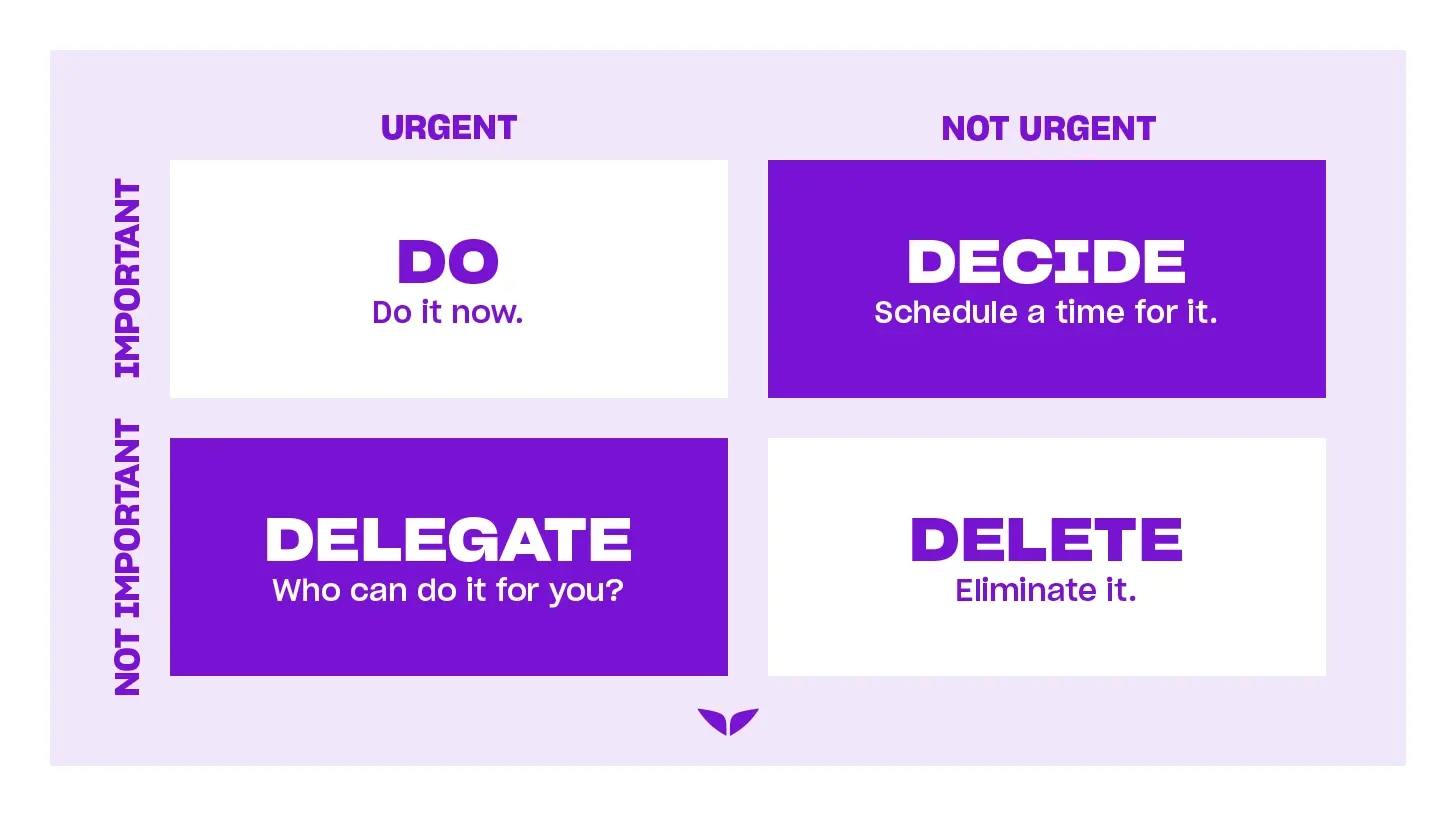
3. The Ivy Lee Method
This simple yet powerful task management technique was developed by a renowned productivity expert, Ivy Lee. It helps you with “how to overcome tasks that pile up in your regular workday,” according to Vishen, the founder of Mindvalley and trainer of the Super Productivity Quest.
So let’s say you have six things you need to do for tomorrow. Using this method, you’d write down those six things in the order of the most important to the least. And what it does is help reduce overwhelm, promote laser-like focus, and boost your motivation.
Here’s how you use it:
- Log whatever tasks come to you, whether it’s something you need to deliver or an idea that you want to turn into a proposal.
- Give each task a ranking. It can be from 1–5 or 1–10, whichever works best for you.
- Budget time in your calendar to accomplish your task.
- Eliminate the most difficult task first.
- Five minutes before the end of your workday, organize your tasks for the next day in terms of importance.
- At the end of each week, check up on your progress and see how well you did (or not do).
4. Time blocking
Time blocking is a way to help you manage your time. It requires you to divide your day into specific blocks dedicated to specific tasks or projects.
For example, you block off one hour in the morning for focused writing. The next block would be for emails. And the next one would be for meetings.
This allows you to reduce distractions and use your time more effectively. And by having such control over your schedule, your anxiety can decrease and your overall well-being can improve.
“In order to live our values in each of these domains, we must reserve time in our schedules to do so,” Nir explains. “Without planning ahead, it’s impossible to even tell the difference between traction and distraction.”
Here’s how you can implement it:
- List all your tasks for the day.
- Allocate realistic time slots for each task.
- Block out dedicated time slots in your calendar for each task.
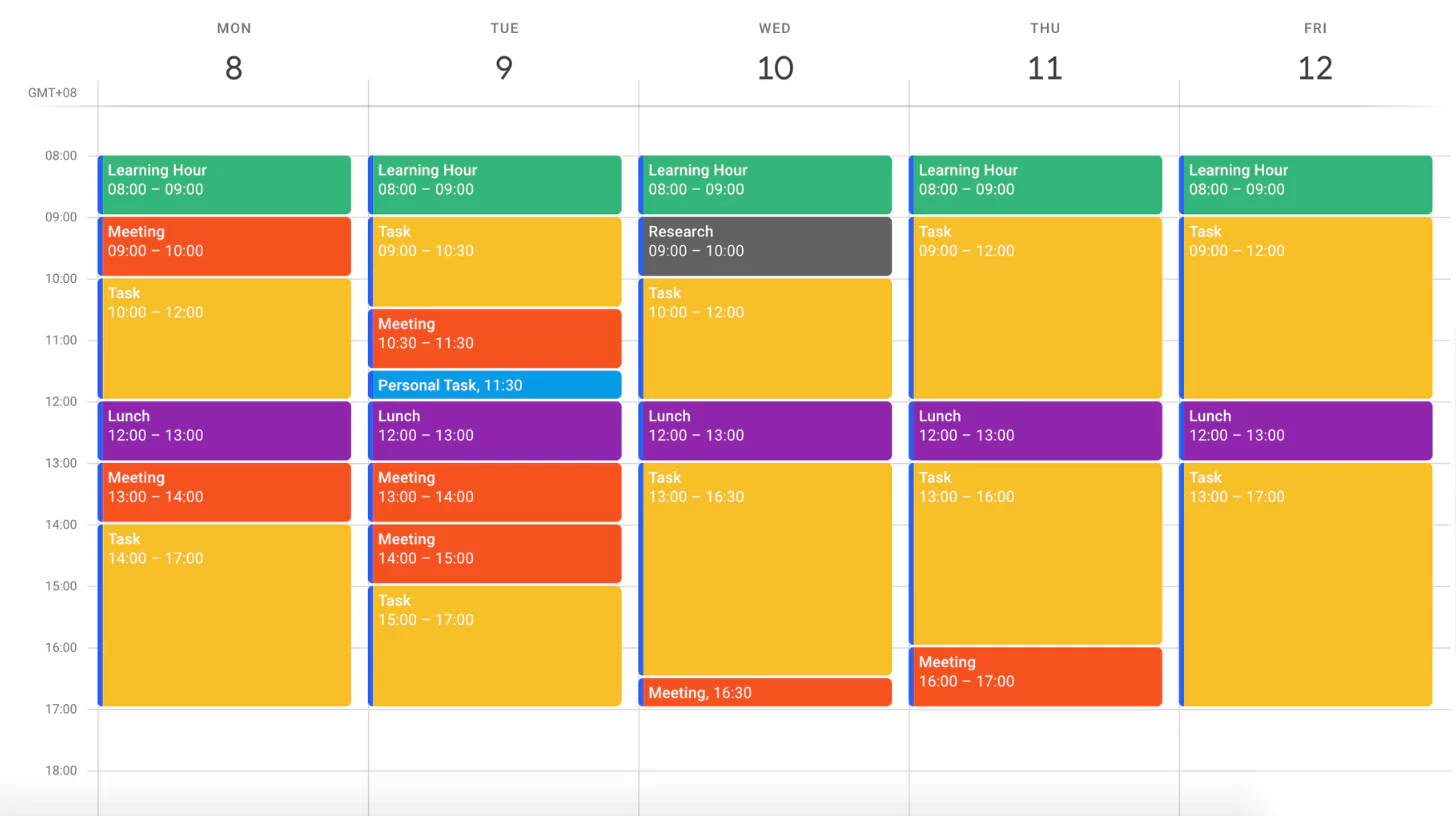
5. Make a pact
According to Nir, there are three basic kinds of pacts: effort, price, and identity.
- An effort pact prevents distraction by making unwanted behaviors more difficult to do. For example, installing an add-on that prevents you from browsing certain sites.
- A price pact adds a cost to getting distracted. For example, “If I don’t go to the gym, I will burn this $100 bill.”
- An identity pact is a precommitment to a self-image. For example, “I am indistractible.”
They’re essentially pre-commitments to help you overcome distractions and achieve your goals.
How to make a pact:
- Identify your goals and distractions.
- Choose the best pact type: effort, price, or identity.
- Create a specific and clear pre-commitment.
- Share your pact with others for accountability (optional).
6. Productivity journal
Few productivity planner tools are as effective as the productivity journal. There are countless calendars and planners out there, but purchasing a journal dedicated to keeping you organized and productive puts you a step ahead of the game.
By dedicating a few minutes each day to jotting down completed tasks, challenges faced, and areas for improvement, you gain valuable insights into your work patterns.
Here’s how you can use it:
- Choose a notebook or app dedicated to journaling.
- After each workday, dedicate 5–10 minutes for reflection.
- Briefly list completed tasks and projects, highlighting any significant achievements.
- Note any challenges faced and potential solutions for future encounters.
- Identify areas where you felt most productive and focused.
7. Dry-erase calendar
This method requires a reusable whiteboard or surface specifically designed to write and erase plans and events. When you have a calendar up that’s clearly visible, it’ll help you remember what needs to be done and when—it’s the whole idea of “in sight, in mind.”
It provides you with a clear overview of your schedule, deadlines, and appointments. What’s more, because it’s dry-erase, you can easily add, modify, or erase information as your plans change.
Here’s how you can use it:
- Place the calendar in a visible location in your workspace or home, preferably in a high-traffic area.
- Write down significant events, deadlines, and appointments. Use different colors to categorize events for easier organization.
- Add new information and erase outdated entries as needed.
8. Mind mapping
Chances are, you’ve heard of mind mapping, the visual brainstorming technique that resembles a web or a branching tree. In the center is the main topic, with radiating branches to connect ideas and sub-ideas.
For instance, imagine you’re planning a party. The topic in the center might be “Party Planning.” Then, the branches could connect to sub-ideas like “food,” “guests,” “decorations,” and so on. Each of these sub-branches could further expand with more specific details.
Having a visual layout can encourage free-flowing connections between one idea and another. What’s more, it helps you see the bigger picture and spark new ideas and connections you might’ve missed with linear note-taking.
Here’s how you can do it:
- Start with a central idea. Write or draw it in the center of a blank page.
- Draw branches to connect the central idea to related topics or sub-ideas.
- Write keywords or phrases on each branch to further elaborate.
- Get creative and use colors, images, and symbols to enhance visual engagement.
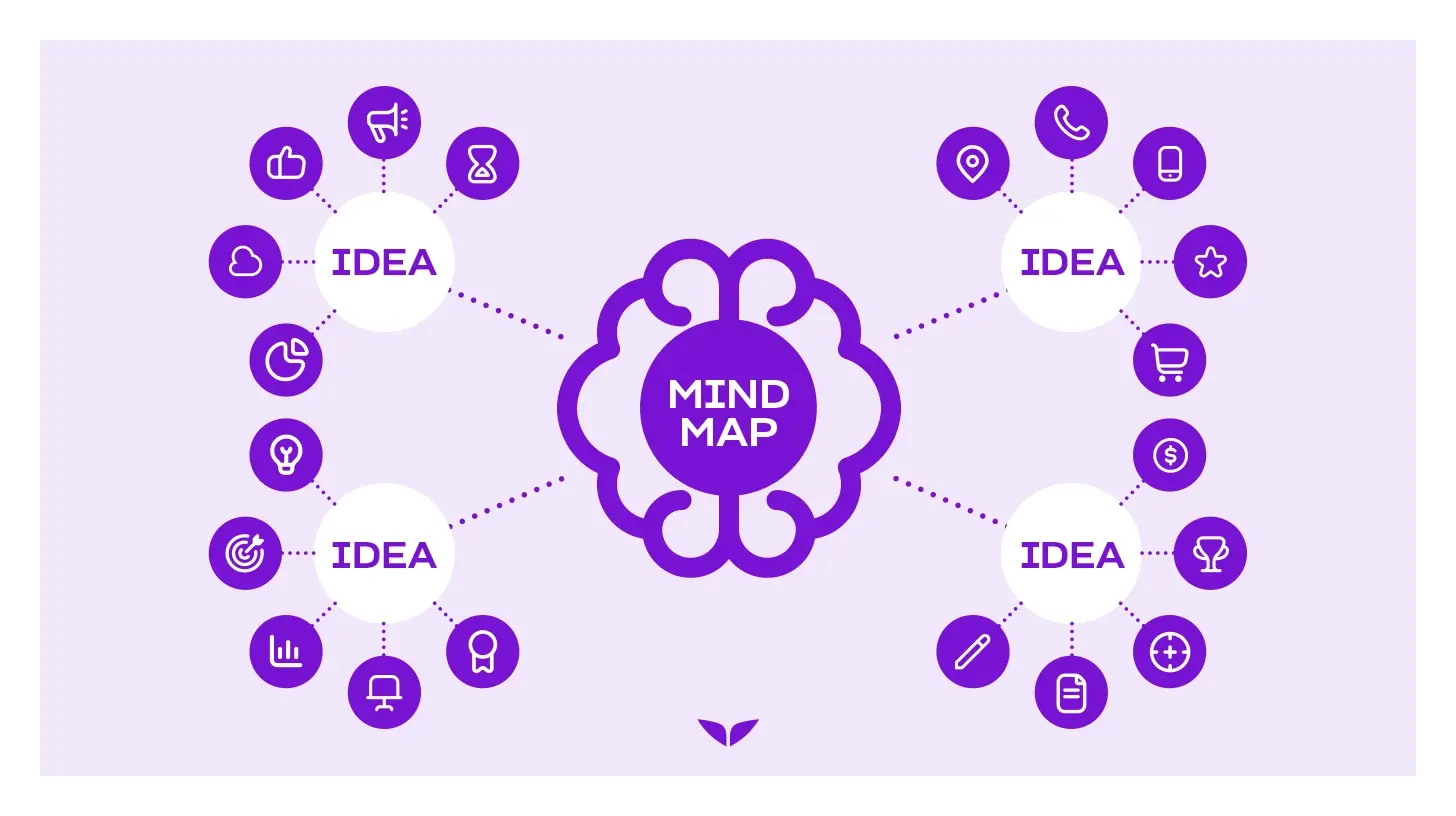
9. Kanban boards
Falling under the category of visual workflow management tools, Kanban boards represent different stages of a task. This can be something like “To Do,” “In Progress,” and “Done,” where each task is represented by a card, and as you progress, you move the card across the columns.
With this method, you’ll be able to quickly see the status of all your tasks as well as track their progress. Then, you can prioritize what you need to work on and avoid multitasking, making your work more efficient.
Here’s how to use kanban boards:
- Use a physical whiteboard, an online tool, or even sticky notes on a wall.
- List the different stages your tasks go through.
- Briefly describe each task on a sticky note or card.
- As tasks progress, move them through the corresponding columns.
10. Two-minute rule
Baby steps is the name of this game. This technique, developed by productivity expert David Allen, suggests tackling any task that can be completed in two minutes or less immediately.
“When I really do not want to do something, I tell myself I’m only going to do it for two minutes, whatever that is,” says Florencia Andres, a mindset coach and trainer of Mindvalley’s The Champion Mindset Quest. “It could be like doing pushups; it could be working on an edit; it could be working on a script, whatever that is.”
By eliminating the mental hurdle of starting these small tasks, you’re more likely to get them done and dusted, avoiding a massive pile-up later on. Additionally, it can feel rewarding to check off something on your list, getting you to stop procrastinating when it comes to larger projects.
Here’s how to use this technique:
- When you encounter a task, estimate what its completion time will be.
- If it takes less than two minutes, do it immediately.
10 best AI productivity tools
Nowadays, artificial intelligence (AI) is everywhere. And undeniably, it’s changing the way we work, from individual efficiency to business operations.
Using AI-powered tools can truly help revolutionize your workflow. Here’s a list of 10 that you can explore:
11. Airtable
If you’re looking for an all-in-one organizer, Airtable’s your go-to. Up front, it looks like any typical spreadsheet. However, it’s got the power of a database.
So imagine organizing information in familiar rows and columns. Now, add in the ability to link data, add attachments, and create unique views, and you’ve got Airtable.
You can use it to:
- Organize anything. Manage projects, track expenses, or plan events—Airtable adapts to your needs.
- Boost collaboration. Share your Airtable bases (workspaces) with your team and work together in real time.
- Simplify complex workflows. Automate tasks, set reminders, and gain valuable insights from your data.
Cost: Free with basic features. There’s also the option of paid plans with additional storage and functionality.
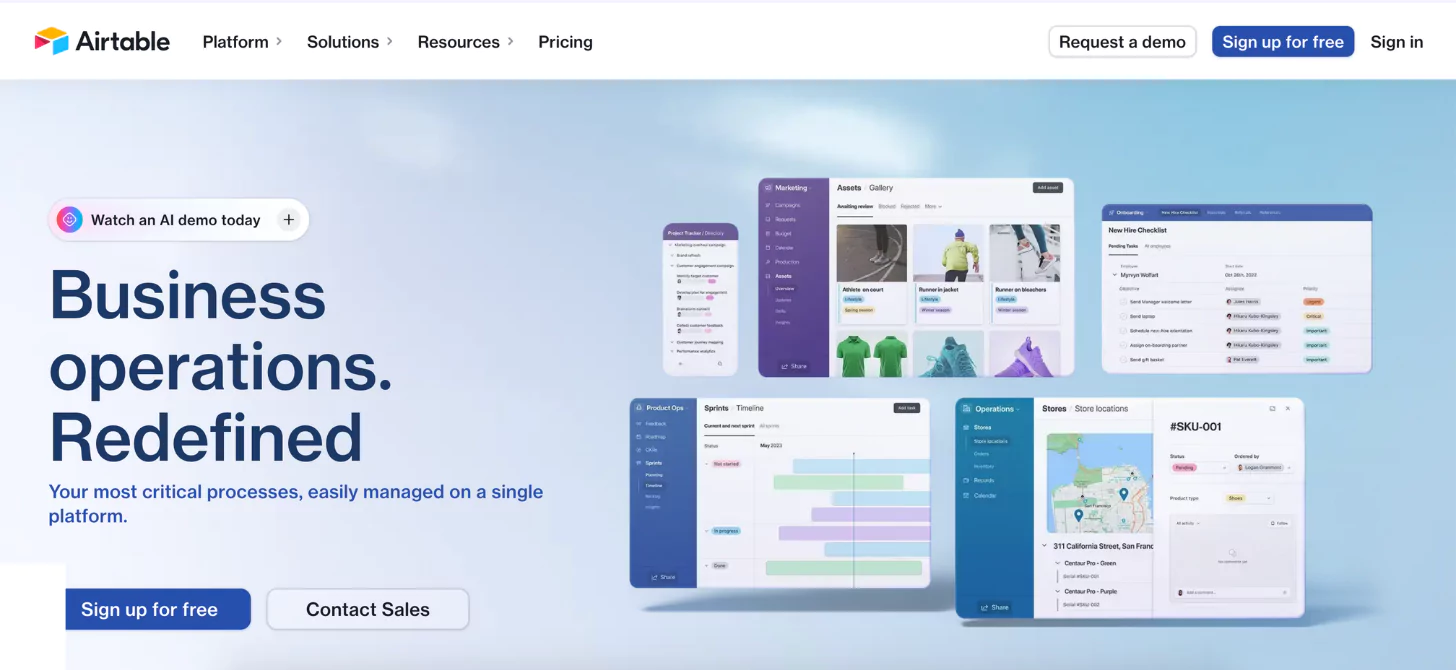
12. ChatGPT
There’s no doubt that ChatGPT is an innovative tool. It can generate human-like text, translate languages, write all sorts of creative content, and answer your questions in an informative way. It’s as close to Iron Man’s J.A.R.V.I.S. as we’re at right now.
You can use it to:
- Boost productivity. Generate content ideas, translate documents, and answer questions, freeing up your time for other tasks.
- Spark creativity. Overcome writer’s block, brainstorm ideas, and explore new writing styles with ChatGPT’s assistance.
- Gain insights. Ask questions and receive informative answers, gaining a deeper understanding of various topics.
Cost: Free with limited features. You can upgrade to premium plans to unlock advanced capabilities and priority access.
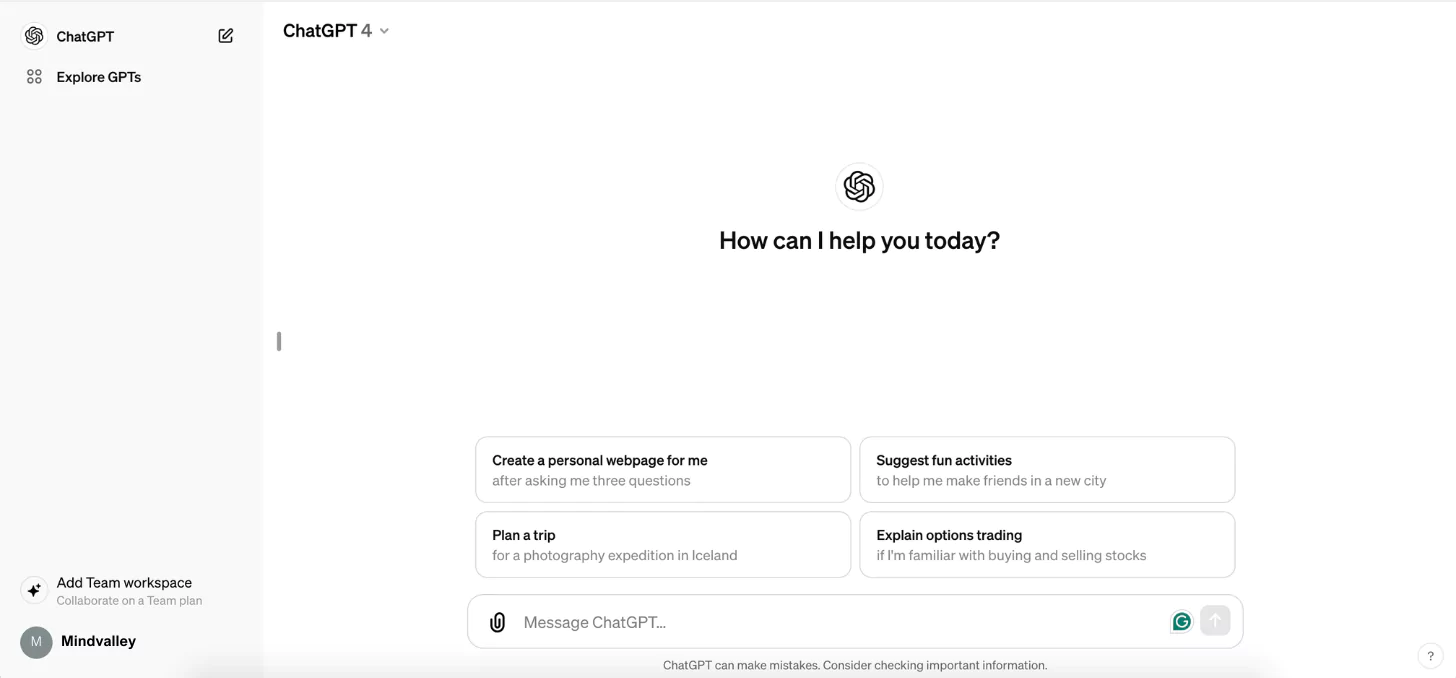
13. Conturata
Granted, using ChatGPT for the first time can be daunting. But even veteran users don’t fully know its full capabilities.
How do you prompt it so that it gives you what you’re looking for? Conturata has made this process so much easier for all of us.
You can use it to:
- Be specific in your prompts. The clearer and more specific your prompts, the better ChatGPT will understand your request and generate the desired output.
- Break down lengthy content into manageable parts with Conturata’s splitting feature. This makes feeding information into ChatGPT smoother and avoids overwhelming the system.
- Unlock diverse content creation. Conturata provides pre-built prompts for diverse content types, empowering you to generate scripts, post descriptions, and more, all within the realm of ChatGPT.
Cost: Free
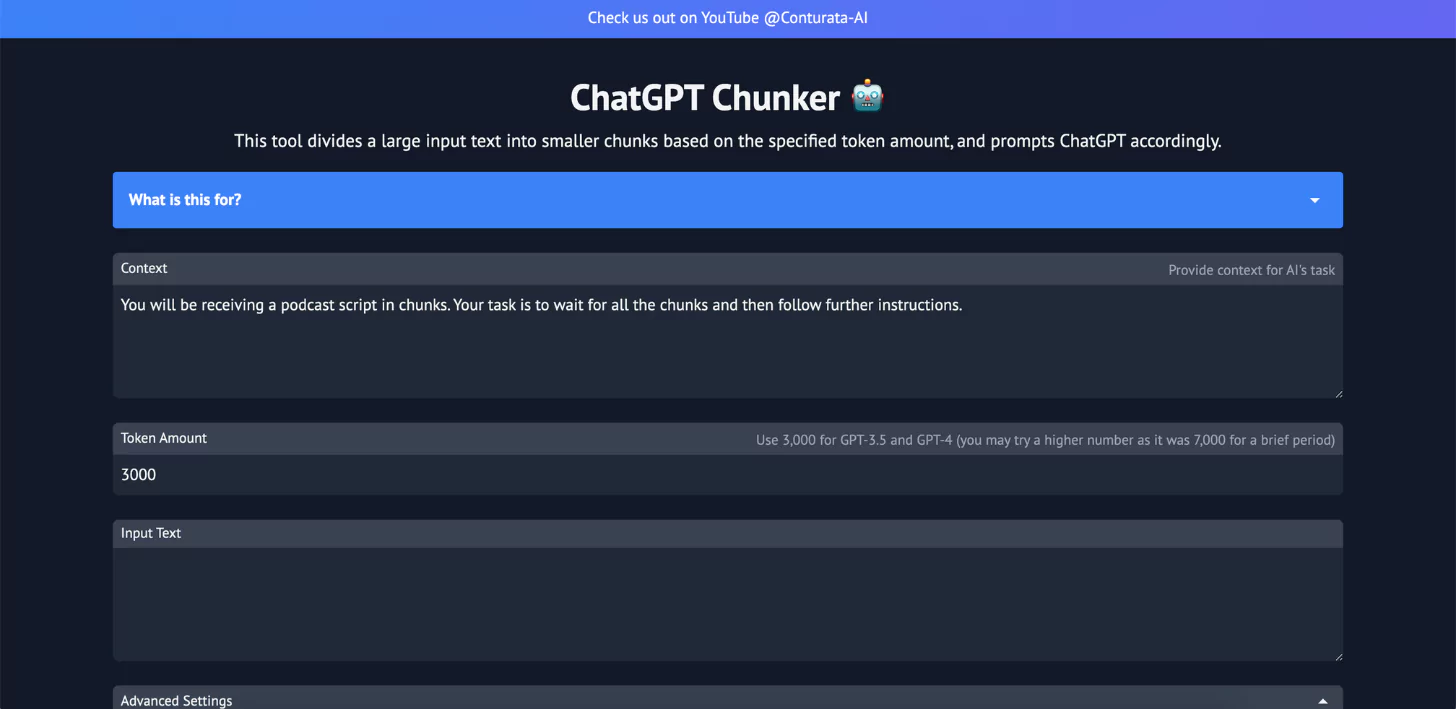
14. QuillBot
If you’re looking to refine your content, QuillBot’s a great tool to use. It uses AI technology to suggest different ways to express your ideas while maintaining their original meaning.
You can use it to:
- Improve your clarity. It suggests alternative phrasing, synonyms, and sentence structures, making your writing clearer and more concise.
- Enhance your creativity. Overcome writer’s block and explore new ways to express yourself by using the tool’s different rephrasing modes (e.g., formal, creative, etc.).
- Boost your grammar and vocabulary. Identify and correct grammatical errors while discovering new vocabulary options to enrich your writing.
Cost: Free with limited features. However, the premium plans unlock additional modes, longer text processing, and more.
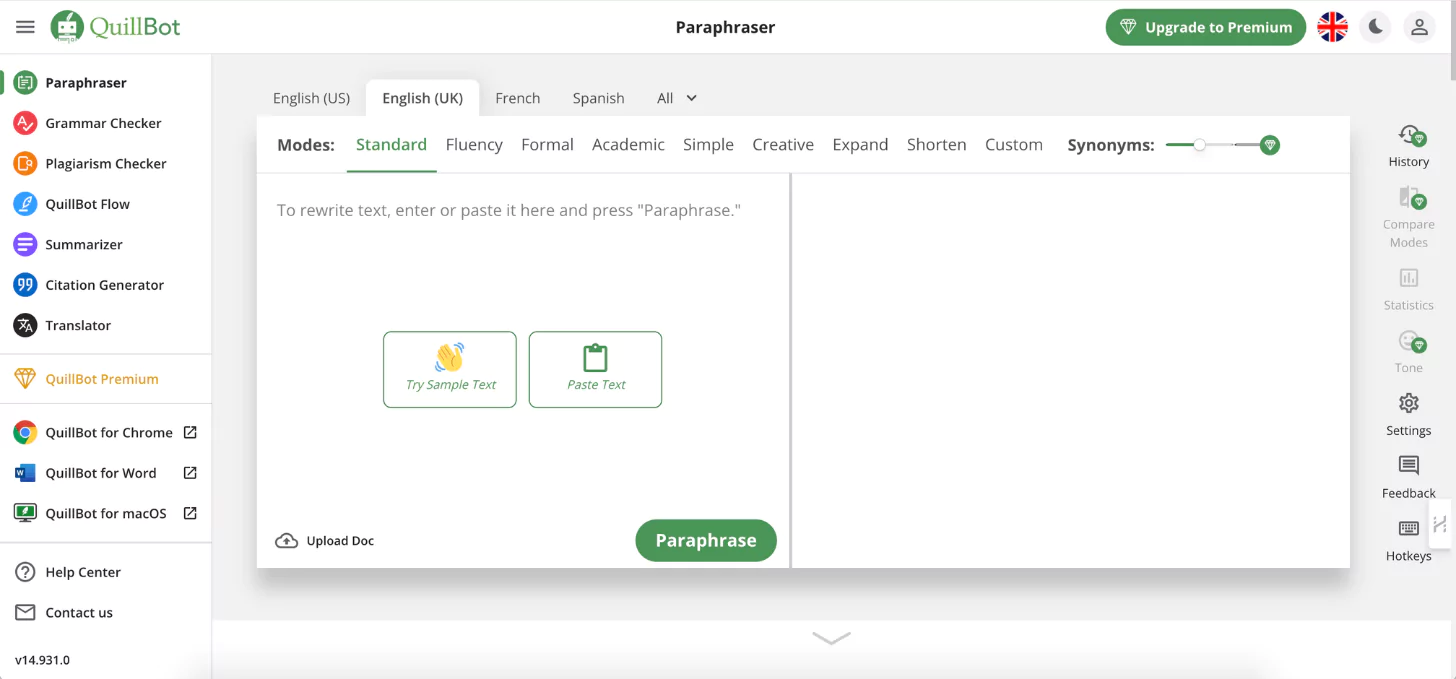
15. Calendly
Imagine this: You’re a busy professional. You’ve got things to do. Endless back-and-forth emails and finding a time to meet with someone shouldn’t be one of them.
With Calendly, all you have to do is share a link with the other person. They can see your available slots and choose a time that works for them, automatically adding it to your calendars.
You can use it to:
- Save time and effort by automating scheduling tasks.
- Provide a centralized platform for managing your calendar and appointments.
- Offer flexibility. It provides options for different meeting types, like video calls or in-person meetings.
Costs: Calendly offers a free plan with limited features, while premium plans unlock additional functionalities like integrations and group scheduling.
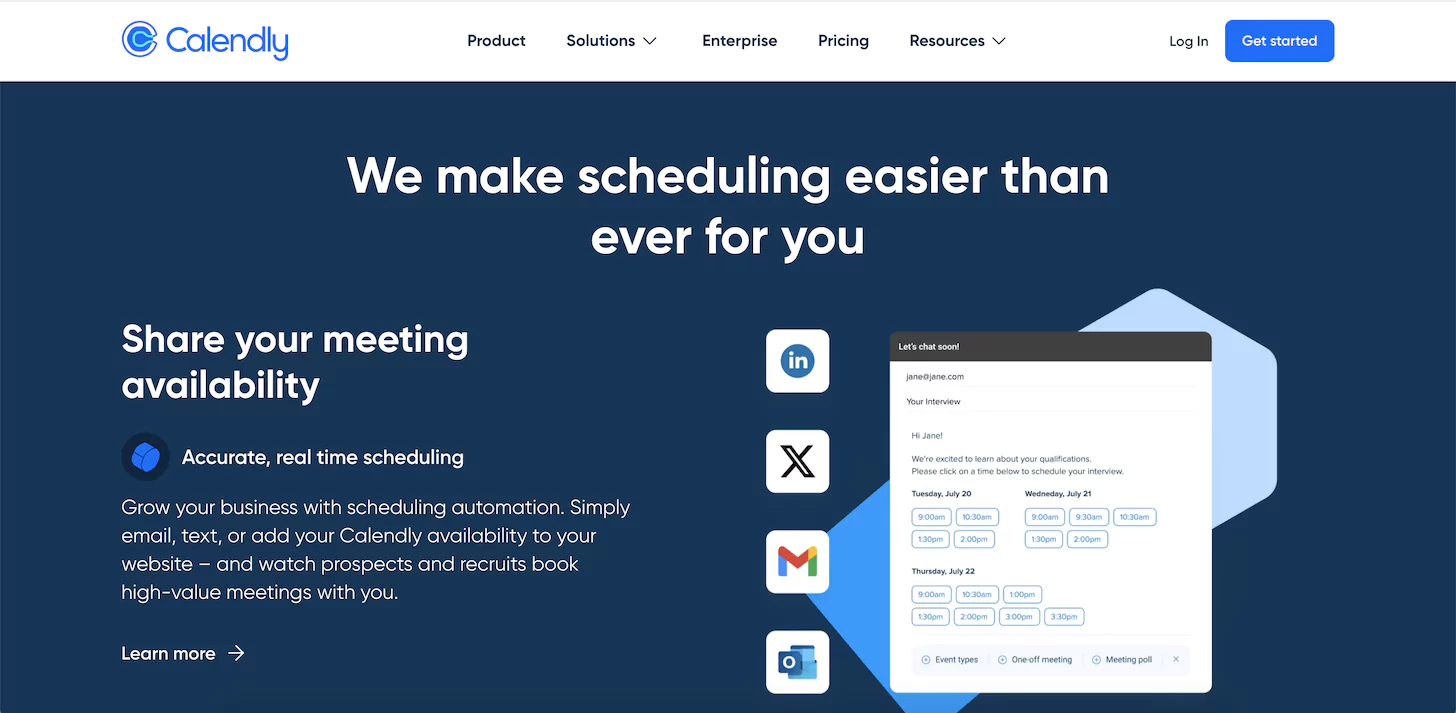
16. Vocable
Vocable.ai is an AI-powered content management platform designed to streamline your workflow and boost productivity. It uses AI to assist with various content creation tasks, like generating content ideas, conducting research, gathering information, paraphrasing, and summarizing text, to name a few.
You can use it to:
- Generate creative content ideas, overcoming your writer’s block.
- Save time and effort by automating repetitive tasks.
- Improve the quality and efficiency of your content creation process.
Costs: Freemium model, with a basic free plan and paid plans with additional features.
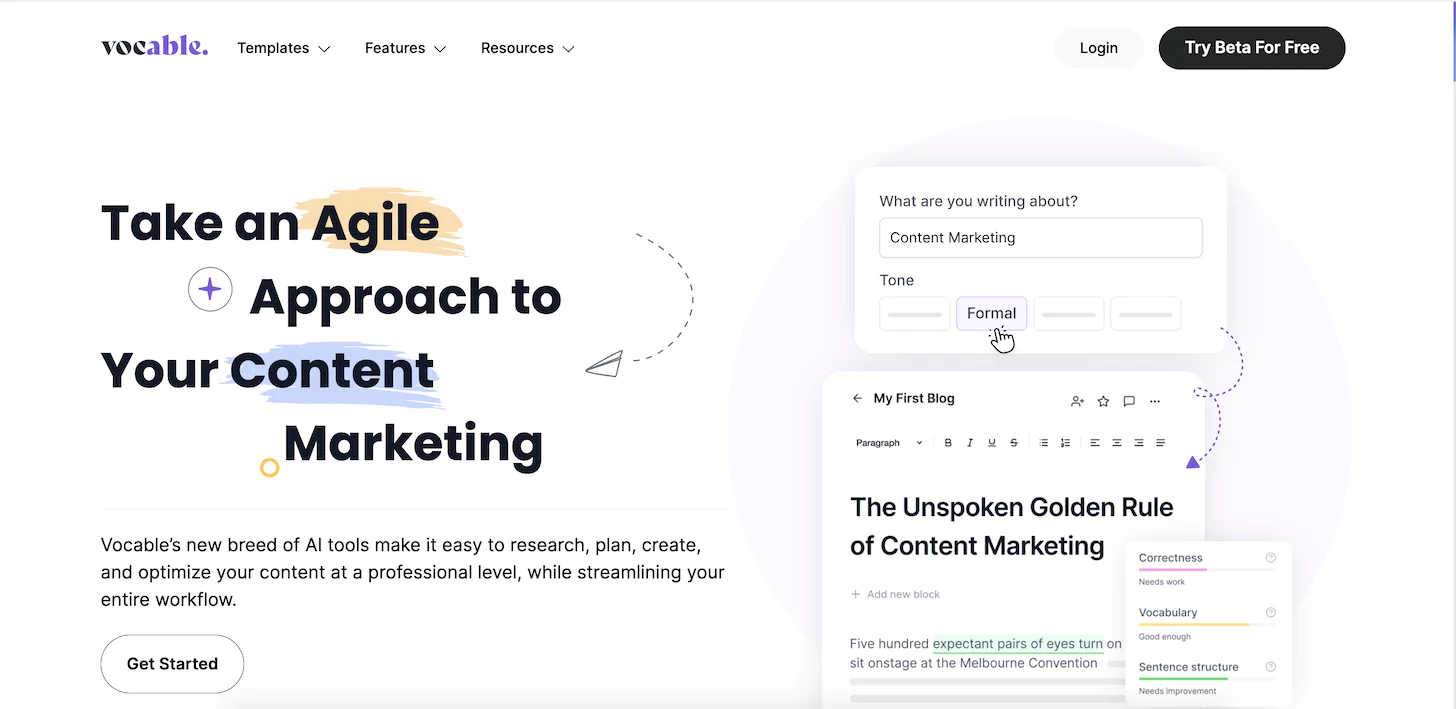
17. Jasper.ai
Shelling out content is a real big chore. But with an AI writing assistant like Jasper.ai, you can create all sorts of copy, like for social media posts, emails, and product descriptions.
You can use it to:
- Generate creative text formats, helping you break through creative roadblocks and produce content efficiently.
- Craft compelling marketing materials that resonate with your audience and improve your overall marketing strategy.
- Save time and resources. You focus on core tasks while Jasper handles the content creation, saving you valuable time and resources.
Cost: Depends on the plan and features chosen.
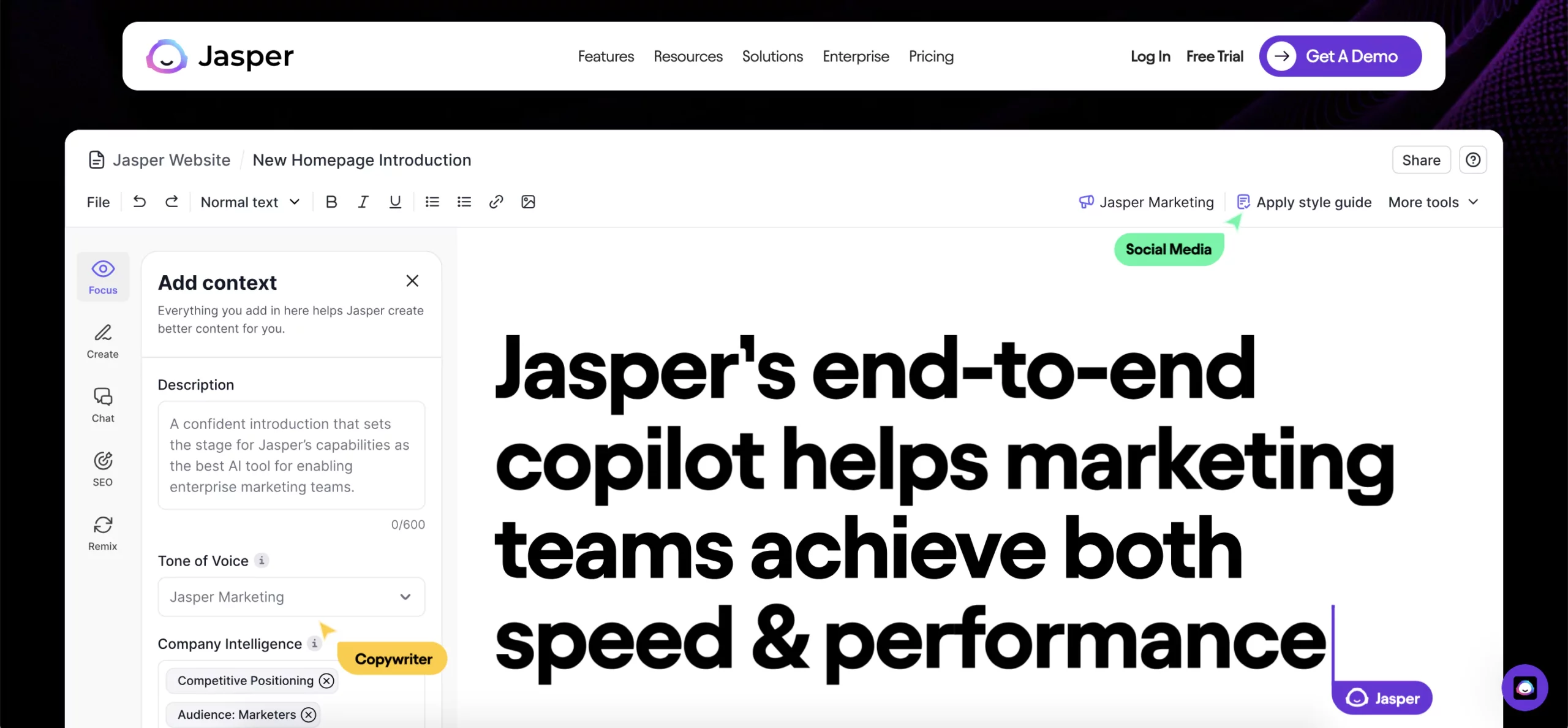
18. Otter.ai
No need for a secretary to take down the minutes. Otter.ai uses AI-powered software to transcribe meetings, interviews, and lectures in real-time.
You can use it to:
- Capture every word, freeing you to actively participate and focus on the conversation.
- Easily review key points and highlights later, thanks to automatic timestamps and speaker identification.
- Share transcripts and recordings with colleagues to ensure everyone stays on the same page.
Cost: Free with basic features. However, the premium plans come with additional features like speaker identification and cloud storage.
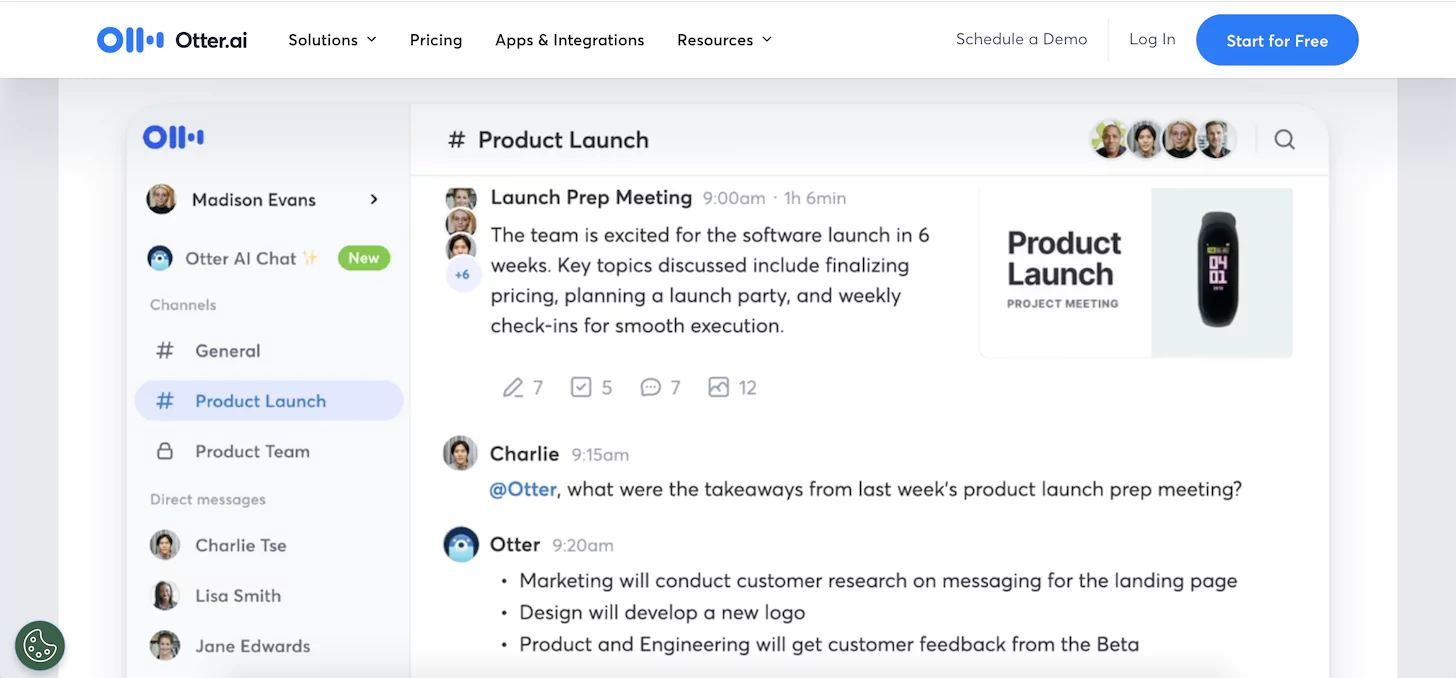
19. Midjourney
If you’re looking to unleash your creative spark, try out Midjourney. It creates stunning and unique visuals that’ll spark your creative exploration.
What’s more, it can help make your work more artistic, should it need such appeal. For example, if you need visuals for a presentation or a social media post and you don’t want to spend hours scouring for the perfect stock photo, you can simply describe your vision in Midjourney (e.g., “a futuristic cityscape at sunset”), and it’ll generate stunning options for you to use.
So while it doesn’t boost task completion, you can use it to:
- Generate visual ideas to overcome creative roadblocks.
- Create visuals quickly and efficiently, saving time compared to traditional methods.
- Use visuals to convey ideas and concepts.
Cost: Paid plans that offer varying levels of access and functionality.
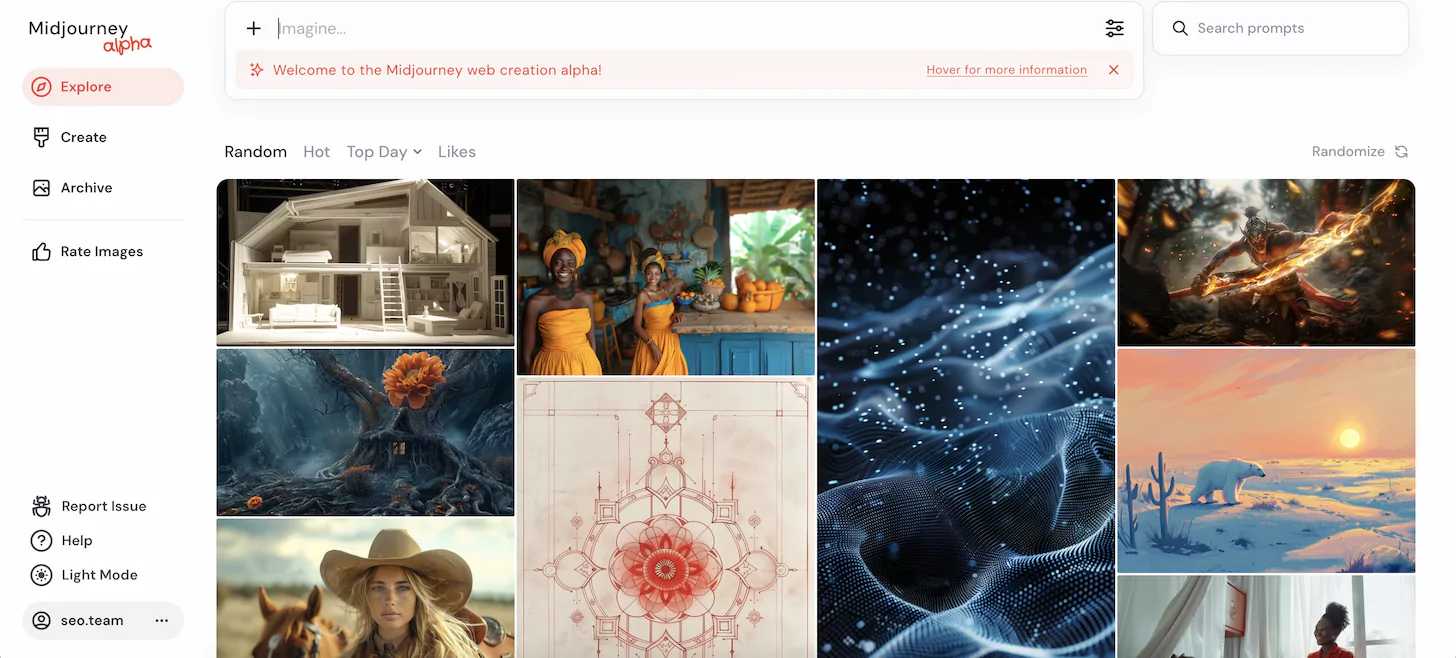
20. Google Meet
Online calls use AI, too. Google Meet, in particular, uses this type of intelligence to enhance the user experience, contributing to a more productive, inclusive, and engaging meeting.
You can use it to:
- Blur distracting backgrounds and minimize background noise, ensuring a professional and focused environment for your meetings.
- Live captioning. This can be particularly helpful for deaf and hard-of-hearing users as well as those following along in different languages.
- Adjust lighting and layouts for optimal video quality and group visibility.
Cost: Free, but some advanced features may require a paid Google Workspace subscription.

10 best productivity apps
Your smartphone might seem like something that would be against your productivity. But what if it could actually become your performance powerhouse?
“Everything is a distraction when we don’t decide for ourselves what we want to do with our time,” Nir explains. And these top 10 productivity apps can help with just that.
21. Google Calendar
A great way to schedule events, set reminders, and stay organized is by putting them on your calendar. That’s where Google Calendar comes in.
It allows you to centralize your schedule in one place, accessible from any device. So even if you’ve used your desktop to put in an entry, you’ll be able to access it from your phone.
You can use it to:
- Stay organized with the ability to view your schedule in various formats (day, week, month).
- Boost productivity by scheduling tasks, setting reminders, and avoiding missed deadlines.
- Collaborate effortlessly with colleagues and friends for seamless coordination.
Cost: Free

22. Cloud storage
Let’s say you’re working on a presentation on your laptop at the office. Then, you continue the dits on your phone during your commute home. That’s the beauty of cloud storage—it keeps your documents, photos, music, and whatnot accessible and synced across all your devices.
Whether you opt for Dropbox, iCloud, Google Drive, or anything of the like, you best believe this digital locker eliminates the need for bulky USD drives or external hard drives.
You can use it to:
- Access your files from any device with an internet connection, increasing flexibility and collaboration.
- Automatically back up your files, keeping them safe and secure.
- Share files and folders easily with colleagues or friends, streamlining teamwork and project management.
23. Slack
Slack is a cloud-based platform designed to centralize team communication. It replaces emails with channels for specific topics or projects, allowing for organized discussions and file sharing.
You can use it to:
- Improve communication by fostering transparency and information flow.
- Share ideas, documents, and project updates.
- Increase productivity by streamlining workflows and reducing reliance on emails.
Cost: Free with limited features. The paid tiers come with additional functionalities.
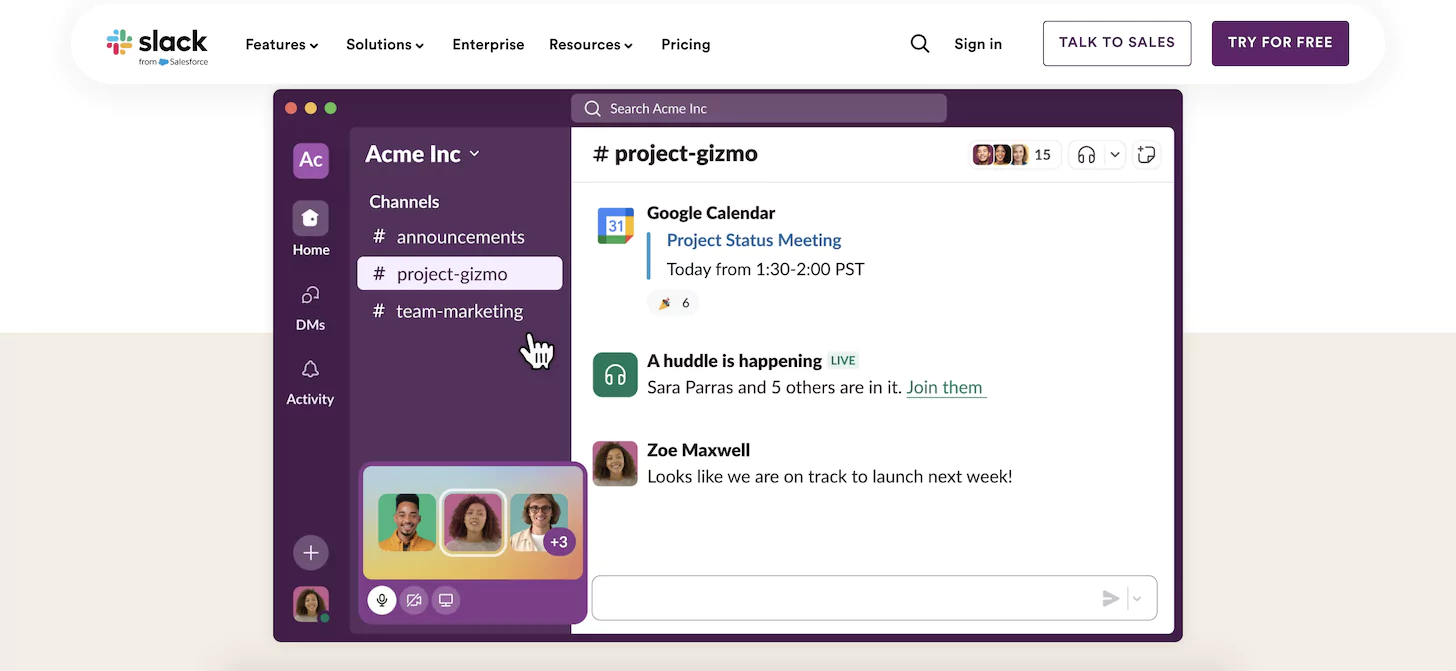
24. Evernote
Evernote offers a central hub for all your notes, to-dos, and multimedia content. So, essentially, you can jot down a grocery list at home, add a research note at the library, and then seamlessly access both on your phone at the store.
You can use it to:
- Organize your thoughts. Your notes, web clippings, images, and audio recordings are in one place and easily searchable for future reference.
- Boost productivity. Create to-do lists, set reminders, and collaborate with others on projects, streamlining your workflow.
- Access information anywhere. Sync your notes across devices, ensuring you have everything you need at your fingertips.
Cost: Free with basic features. The premium plans include additional storage and collaboration options.
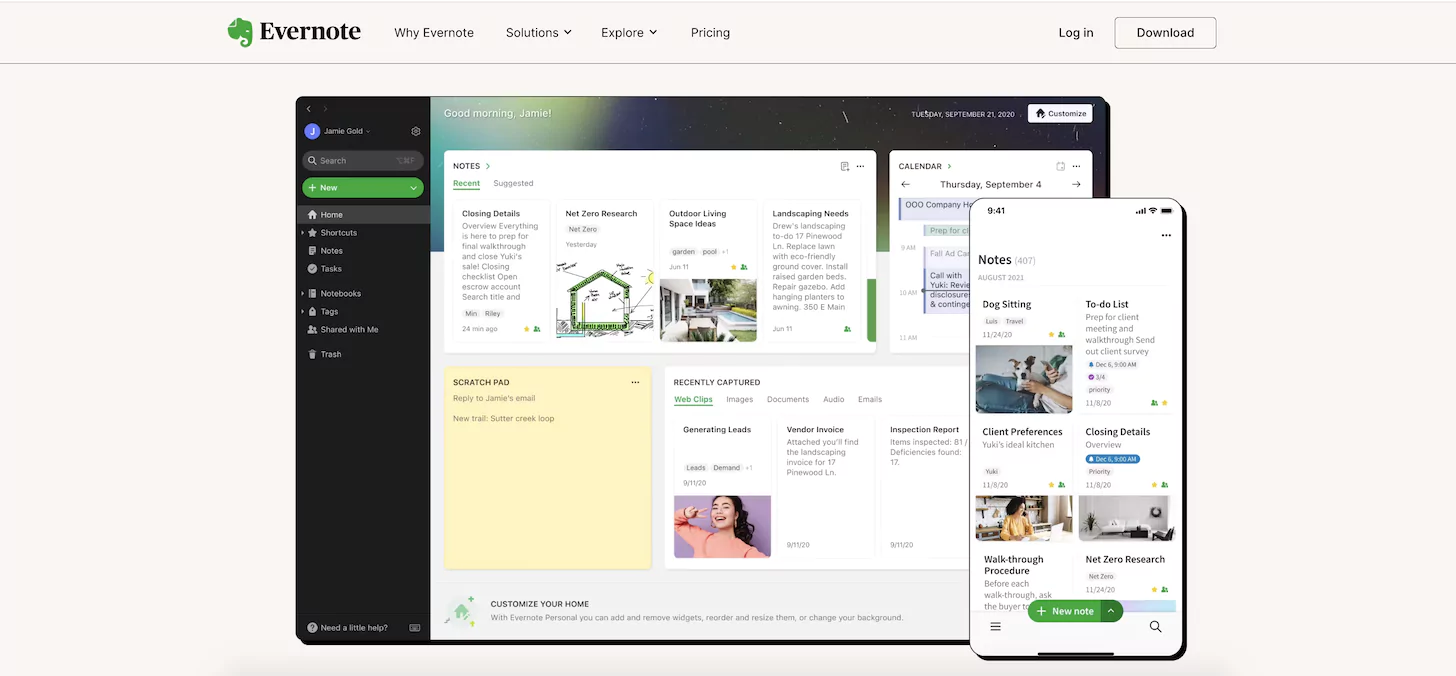
25. Obsidian
There’s the form of note-taking we’re all familiar with. And then there’s Obsidian—a unique note-taking app that lets you connect your ideas freely.
Why would you want to do that, you may ask? Well, it creates a web of interconnected thoughts. So let’s say you’re researching a historical event. In Obsidian, you can create separate notes for different aspects (such as key figures, causes, timelines, etc.) and link them together.
You can use it to:
- Organize knowledge. You can create notes on any topic, link them to related concepts, and build a comprehensive knowledge base.
- Connect ideas and explore diverse perspectives, fostering deeper understanding.
- Improve your writing by leveraging the interconnected nature of your notes to craft well-structured documents.
Cost: Free
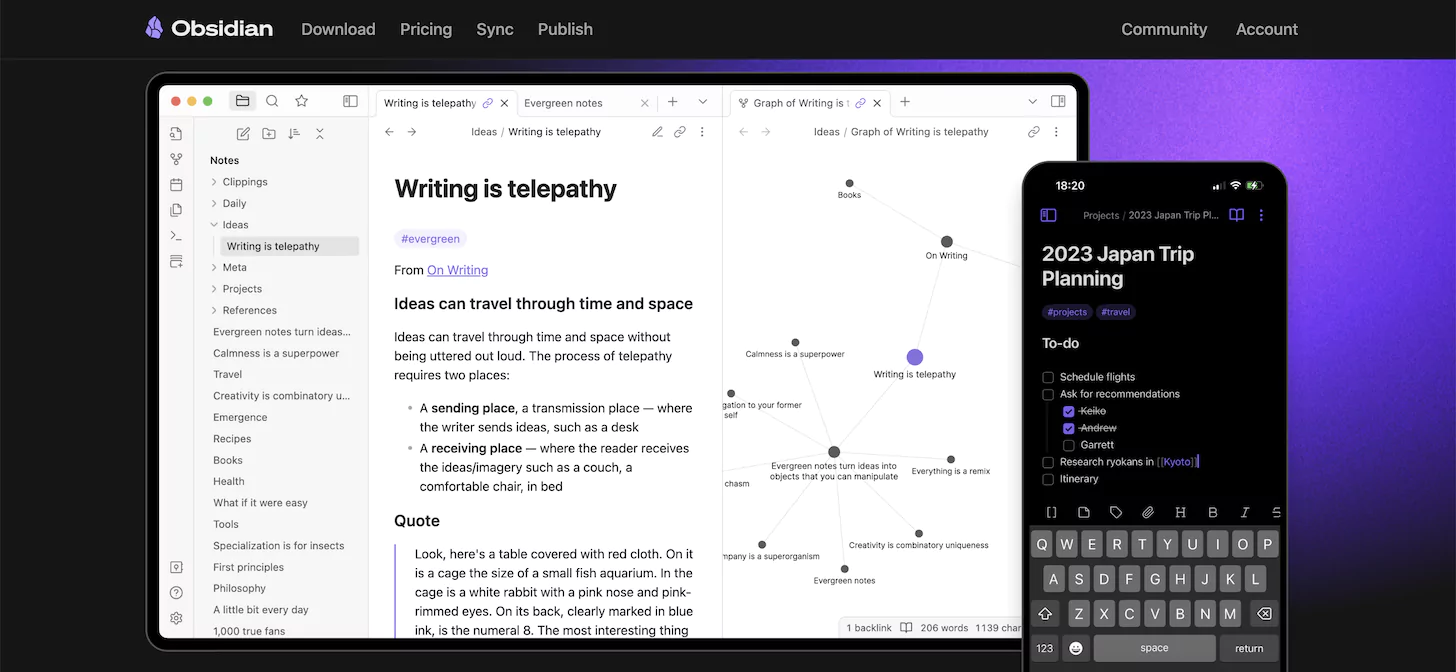
26. Forest
If you’re the kind to get distracted by the constant happenings on your phone, then Forest might be the tool for you. It’s a gamified productivity app that uses positive reinforcement to help you stay focused.
Here’s how it works: Let’s say you want to write for an hour without checking your phone. Plant a virtual tree in the app. As you stay focused and avoid temptation, your tree grows. However, if you do pick up your device, the tree dies.
You can use it to:
- Boost your focus and motivation and prevent distractions from hindering your progress.
- Increase your self-awareness. Watching your virtual tree wither due to phone use creates a tangible reminder of the consequences of distraction.
- Minimize distractions, so you can complete tasks more efficiently and achieve your goals faster.
Cost: Free with basic features. The premium plans include additional functionalities.
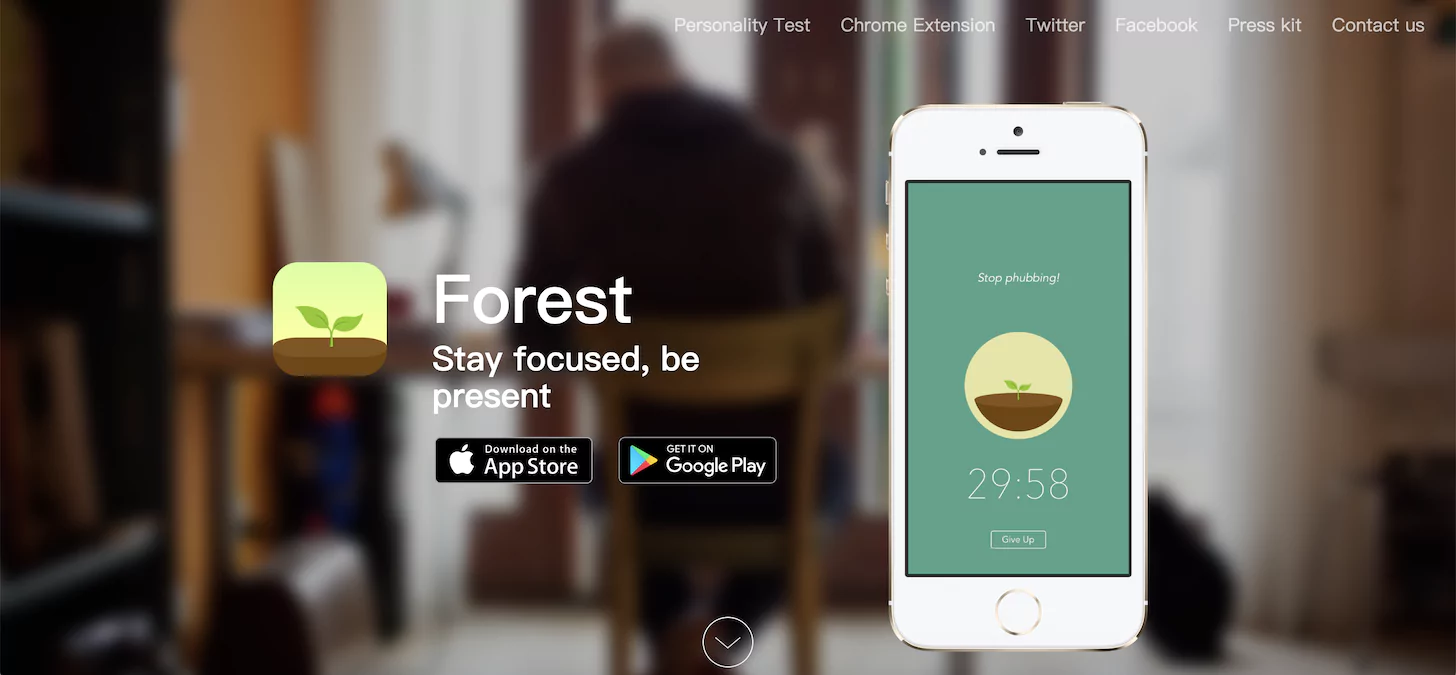
27. Freedom
“Why can’t I focus?” That’s what we often ask ourselves when we’ve got too many things taking up our attention.
Freedom is an app that helps you reclaim focus.
You can use it to:
- Silence distractions on your phone, creating a distraction-free zone and allowing you to work uninterrupted.
- Reduce procrastination, allowing you to stay on track with your tasks.
- Increase productivity, so you can work more efficiently and achieve your goals faster.
Cost: Free on a trial basis. Then, paid plans are available.
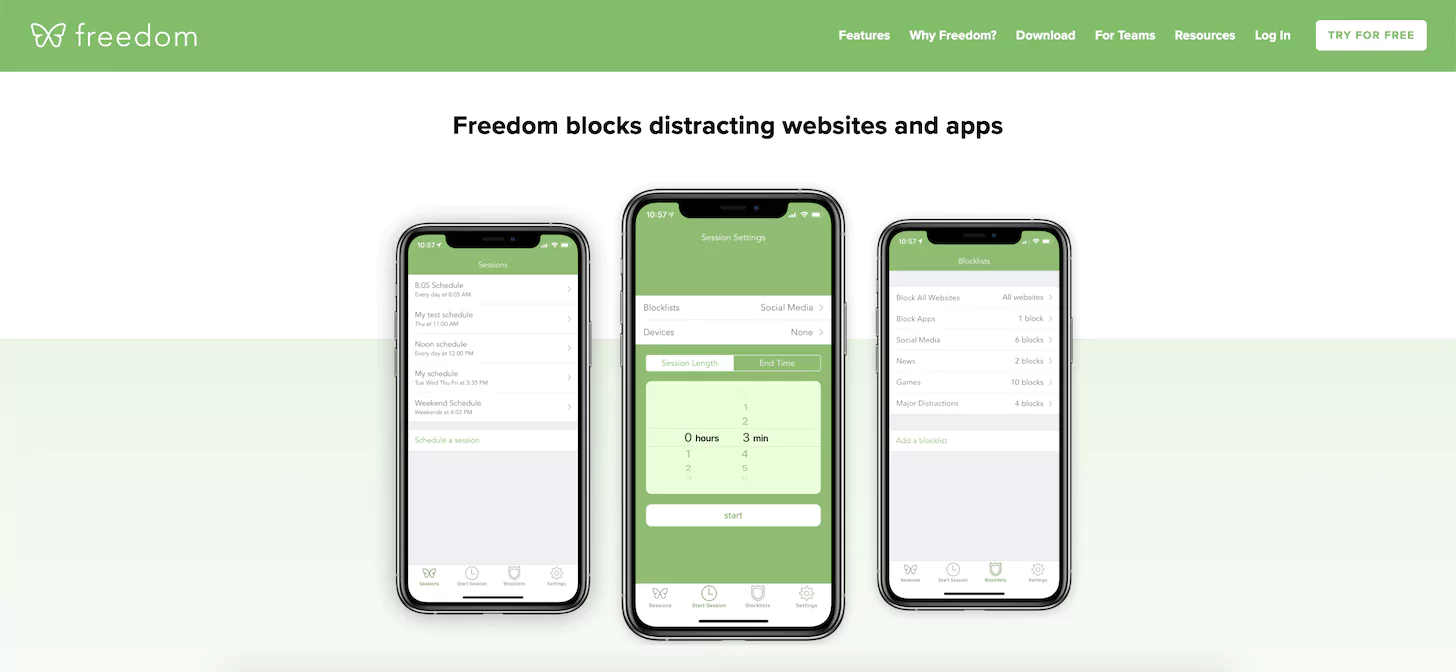
28. Todoist
Juggling errands, work deadlines, and personal projects—so many things, so little time. Good thing Todoist can help you organize and manage your tasks.
Cleverly combining “to do” and “list,” this tool lets you create lists for groceries, set a reminder to pay bills, and even collaborate with your family on a vacation itinerary.
You can use it to:
- Categorize and prioritize tasks, promoting clear focus and streamlined workflow.
- Set reminders, track progress, and stay motivated, enabling you to achieve more in less time.
- Share lists and collaborate with others, fostering teamwork and project transparency.
Cost: Free with limited features. The premium plans, however, unlock advanced functionalities like recurring tasks and labels.
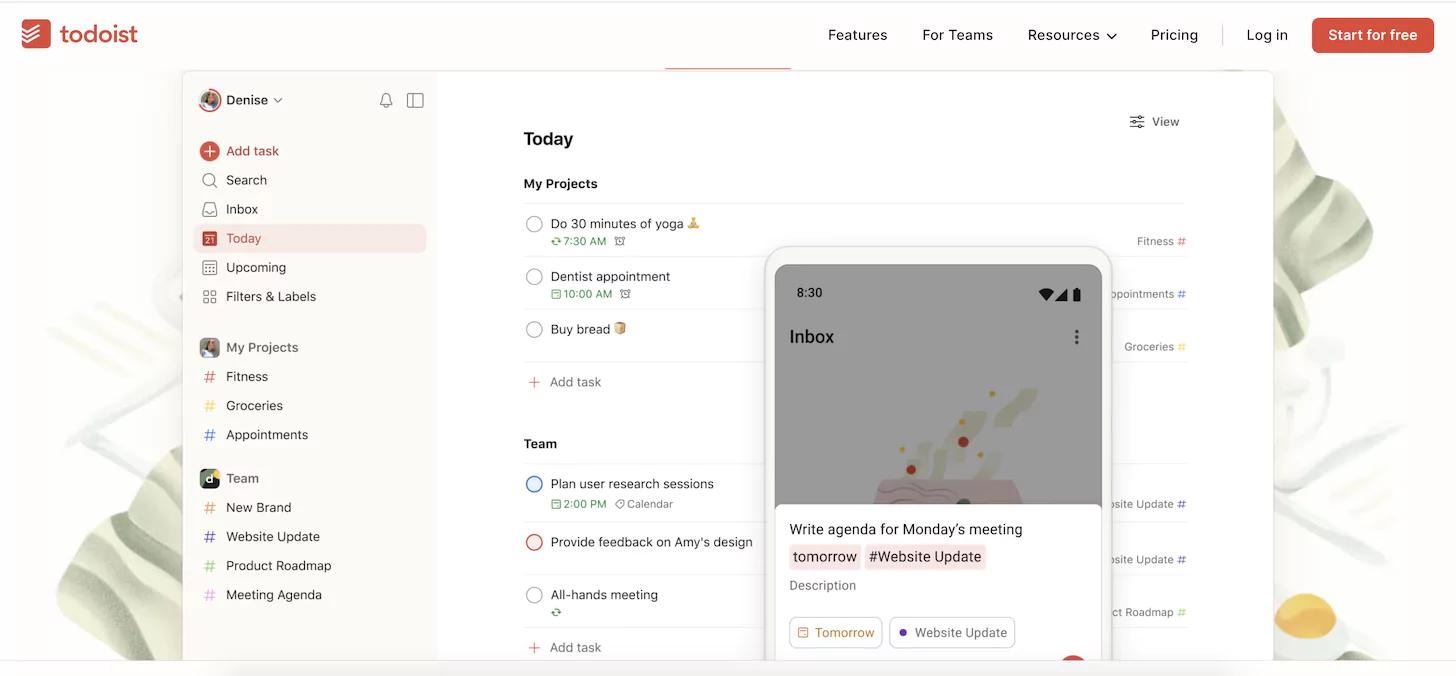
29. Pocket
“In your pocket”—that’s the analogy that the Pocket app is named after. It’s essentially putting interesting articles, videos, and webpages you find online “in your pocket” so you can access them easily later, just like you would with physical material you save.
You can use it to:
- Declutter your reading list, removing content you find interesting from your browser tabs or to-do lists.
- Access saved content even without an internet connection, making it perfect for commutes or travel
- Organize your content, making it easier to find what you’re looking for later.
Cost: Free with limited storage and features. A premium plan provides additional features like permanent storage and full-text search.
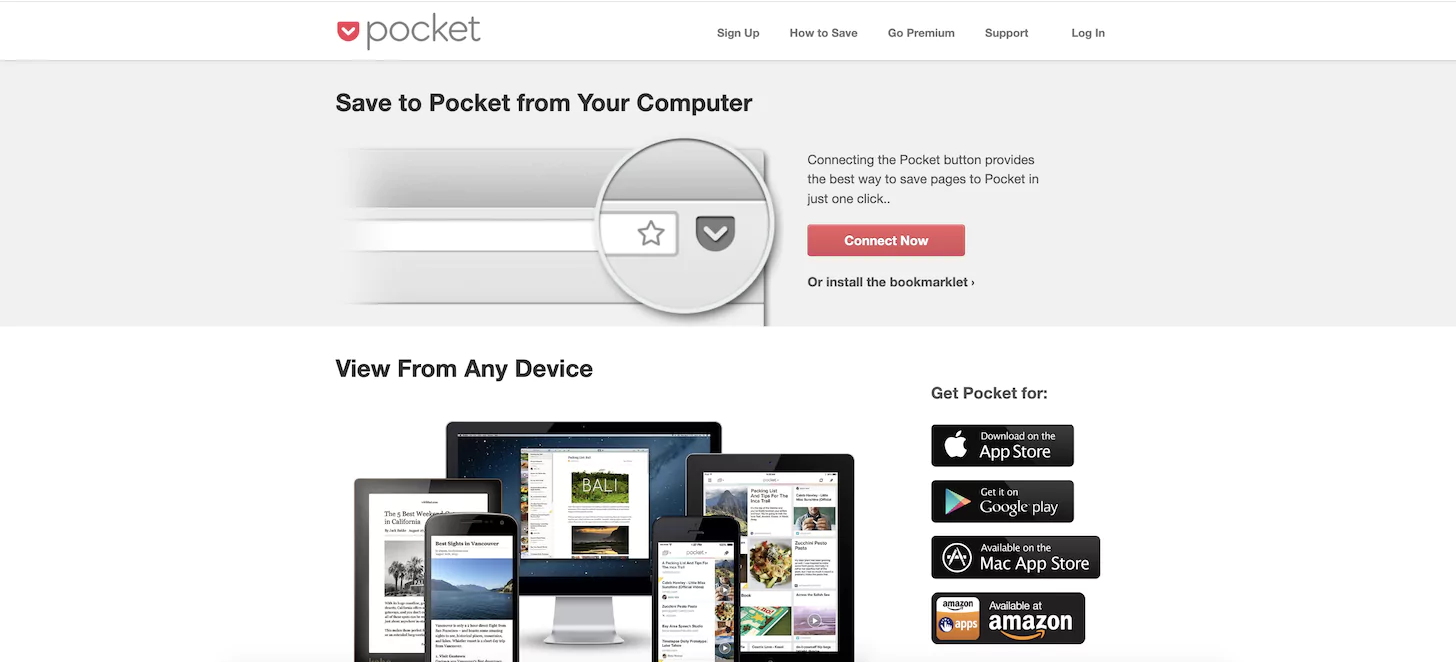
30. Canva
Need social media graphics for your next marketing campaign? A quick infographic for your meeting? A presentation deck?
Canva’s one of the best productivity tools out there that’s got all of it. There are templates and intuitive tools you can use to design eye-catching, professional-looking visuals in minutes, from your phone or computer.
You can use it to:
- Create professional graphics like social media posts, presentations, posters, and more, even without design experience.
- Save time and resources by using pre-made templates and avoiding the need for expensive design software.
- Share your designs with team members for real-time collaboration and feedback.
Cost: Free with basic features. The premium plans, however, include additional features like stock photos and unlimited storage.
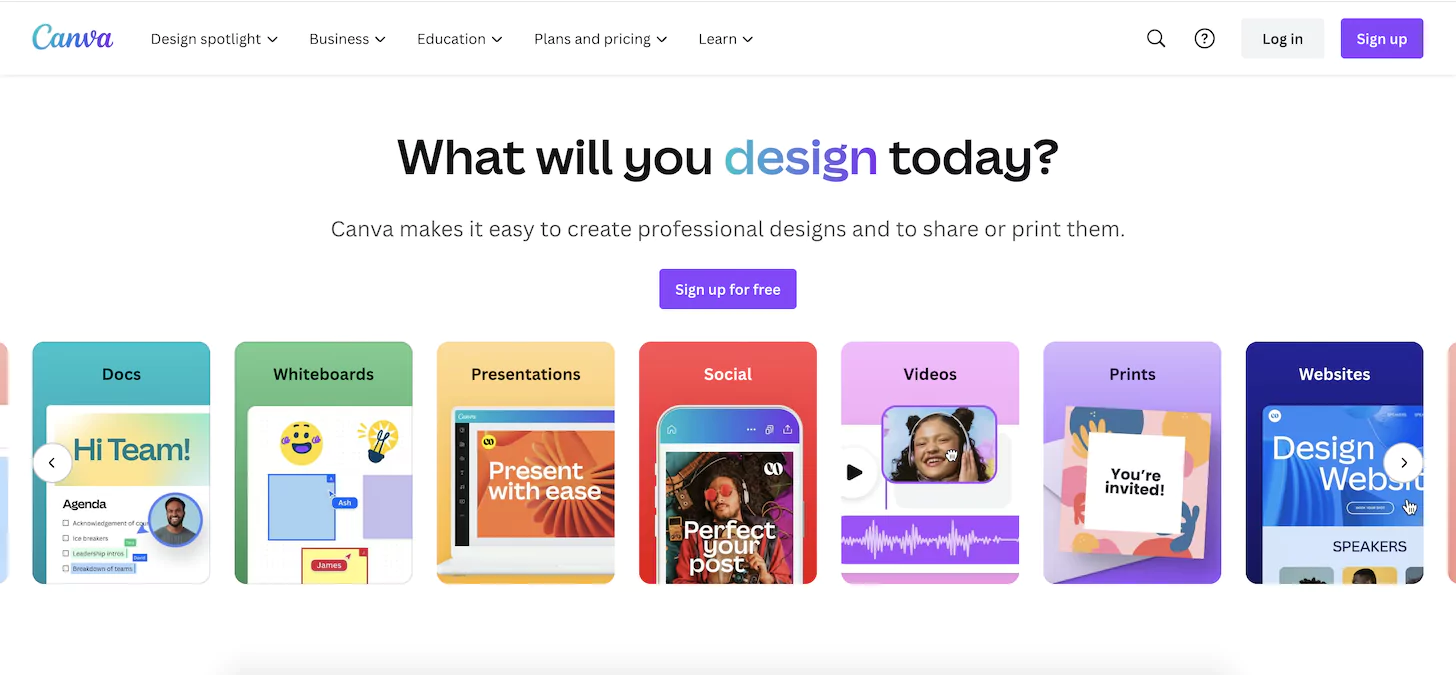
Fuel your future
Productivity tools can be a great asset in helping you achieve your goals. However, they can only take you so far.
The thing is, being efficient, organized, and productive is all about working smarter, not harder. And you can learn how in Mindvalley’s free Becoming Focused and Indistractable masterclass with Nir Eyal.
“The fact is, you can’t call something a distraction unless you know what it distracted you from,” he says. And in the 73-minute session, you’ll discover the secrets to becoming “indistractable,” learning powerful techniques to overcome distractions, boost productivity, and unlock your true potential.
Welcome in.
